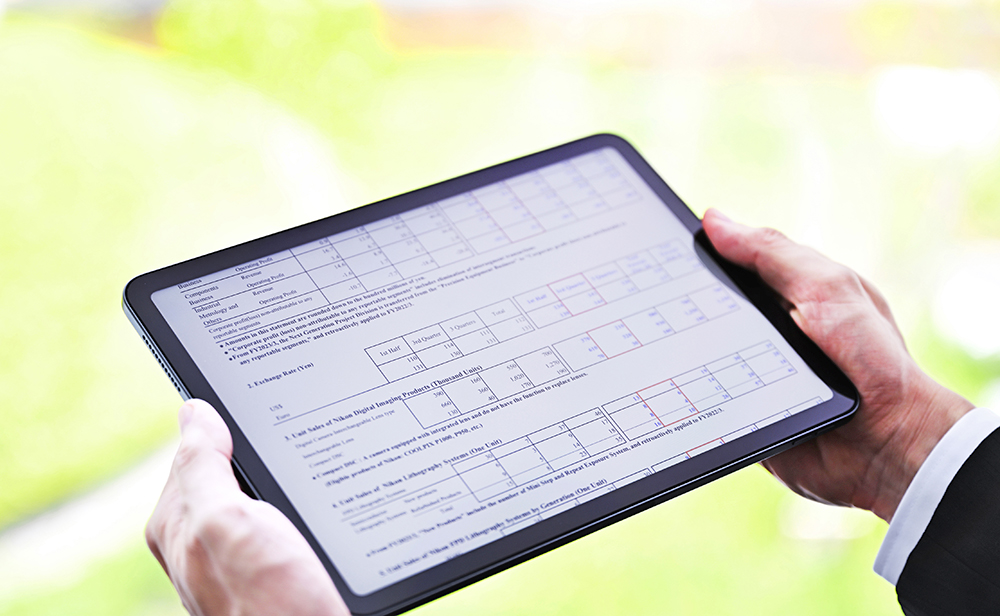Message from the CFO
August 2025

Upon my appointment as CFO
I would like to take this opportunity to introduce myself. My name is Takeshi Matsumoto, and I was appointed as CFO of Nikon in April 2025, succeeding President Tokunari in this role.Over the past 20 years, I have worked at financial institutions in both Japan and the United States, primarily providing advisory services on M&A strategies, capital financing, and investor relations arrangements for major Japanese technology companies. Nikon, one of my key clients during that time, welcomed me into the Company in May 2021. Since then, I have served as the head of the finance and accounting division, and I am now honored to take on the responsibilities of CFO. As CFO, I will accelerate the initiatives pursued by my predecessor—including active engagement with shareholders and investors, disciplined finance management to support sustainable growth, and efforts to increase corporate value.
Currently, while sales of the Imaging Products Business have been satisfactory, the downturn in the semiconductor-related business due to the delay of the market recovery and the tariff policy in the U.S., etc. is having a significant impact on Nikon’s overall performance.
While improving profitability remains a top priority, it is also essential that we continue to invest by clarifying our focus areas and setting priorities as we advance toward realizing our Vision 2030—"A key technology solutions company in a global society where humans and machines co-create seamlessly"—and enhance Nikon’s long-term corporate value.
We will shift to a business operation that considers not only the profit and loss statement but also the balance sheet and cash flow. By maintaining financial soundness and conducting business management that efficiently allocates our limited capital, we aim to support Nikon’s sustainable growth and corporate value creation, leveraging the Company’s technological strengths.
Looking back at FY2024
In the fiscal year 2024, which was the third year of the Medium-Term Management Plan, revenue decreased 1.9 billion yen year on year to 715.2 billion yen, operating profit decreased 37.3 billion yen year on year to 2.4 billion yen, profit attributable to owners of parent decreased 26.4 billion yen year on year to 6.1 billion yen, and ROE was 0.9%.
In terms of revenue, sales in the Imaging Products Business, the Healthcare Business, and the Digital Manufacturing Business performed strongly, resulting in increased revenue. However, sales in semiconductor-related businesses within the Precision Equipment Business and the Components Business declined, leading to a slight decrease in overall company revenue compared to the previous year.
Operating profit declined significantly due to the recording of one-time expenses totaling 27.2 billion yen across the company. This includes 14.1 billion yen in the Precision Equipment Business’s Semiconductor Lithography Business, resulting from a review of future plans, comprising impairment losses on fixed assets, inventory valuation losses, and structural reform costs related to the optimization of service bases.
Outlook for FY2025 (Details announced in May 2025)
For FY2025, the final year of the Medium-Term Management Plan, we forecast revenue of 710.0 billion yen, operating profit of 36.0 billion yen (an operating margin of 5.1%), and profit attributable to owners of parent of 30.0 billion yen.
While revenue growth is expected in the Components Business and the Digital Manufacturing Business, overall company revenue is forecast to be effectively flat year on year due to a decline in sales volume and service revenue for ArF immersion lithography systems—our main product in the Semiconductor Lithography Business—as well as the assumption of a stronger yen compared to the previous year.
On the other hand, operating profit is expected to increase, driven by revenue growth in certain businesses and the absence of one-time expenses recorded in the previous fiscal year. In addition, we will pursue self-help efforts such as the sale of idle assets and reductions in R&D expenses. We also anticipate the positive effects of restructuring implemented in FY2024.
As a result, we are planning a significant year-on-year increase in operating profit of 33.6 billion yen. ROE is projected to be 4.7%.
While earnings are expected to improve compared to FY2024, we anticipate falling significantly short of the Medium-Term Management Plan targets, which include revenue of 700.0 billion yen, an operating margin of 10% or more (operating profit of 70.0 billion yen or more), and ROE of 8% or higher—except for revenue, which is expected to meet the goal. We recognize that improving profitability is an urgent priority. To this end, we will pursue fixed cost reductions and enhance balance sheet efficiency—working together with the entire company toward performance recovery.
Please note that the above earnings forecast does not reflect the potential impact of reciprocal tariffs imposed by the U.S. government. As of May, we estimate a negative impact of approximately 10.0 billion yen on operating profit, but this estimate will be updated as more information becomes available.

As we approach 2030, the Precision Equipment Business aims to drive revenue growth through next-generation lithography systems and diversification of its customer base. The Imaging Products Business will focus on securing stable profits by introducing competitive professional cinema cameras and acquiring new customers, including those among the younger generations. We also plan to steadily expand earnings in the Healthcare and the Components Businesses, both of which offer relatively high operating margins. Meanwhile, the Digital Manufacturing Business will strive for revenue growth that outpaces the overall industry in metal additive manufacturing, while working to reduce operating losses at an early stage.

Capital allocation—selective and focused R&D Investment
To achieve the growth outlined in our Medium-Term Management Plan, we will allocate 80% or more of available funds for distribution to growth investments, as an R&D-driven company.
While remaining open to potential future opportunities, we have completed the current phase of strategic investments with large-scale M&A such as the acquisitions of SLM Solutions Group AG (now Nikon SLM Solutions AG) and RED Digital Cinema, Inc. (hereinafter “RED”)—and we will shift our focus to maximizing synergies with RED regarding professional cinema cameras, advancing next-generation lithography systems in the Precision Equipment Business, and expanding metal additive manufacturing in the Digital Manufacturing Business. These three domains have been identified as priority areas for concentrated capital investment going forward.

Regarding shareholder returns, as part of our efforts to enhance management with greater awareness of capital costs and stock price performance, we carried out a 30.0 billion yen share repurchase in FY2024, utilizing funds generated through balance sheet optimization measures such as the sale of cross-shareholdings.
Although we initially planned to gradually increase annual dividends to 60 yen per share by FY 2025, we have decided to maintain the annual dividend at 50 yen per share for both FY2024 and FY2025. As a result, the total shareholder return ratio during the period of the Medium-Term Management Plan is projected to reach 111.3%, exceeding our target of 40% or more.

In FY2024, Nikon entered a net debt position for the first time in 16 years—meaning that interest-bearing debt exceeded cash and cash equivalents. In order to enhance shareholder value while maintaining financial soundness, we recognize that it is more important than ever to conduct corporate management with a strong focus on financial discipline and capital efficiency.
By working to establish effective management practices throughout the Company for our balance sheet and cash flow, we also work toward sustainable enhancement of Nikon’s corporate value through profitability improvements, selective investments in growth businesses, and stable shareholder returns.
We sincerely appreciate the continued understanding and support of all our stakeholders.



